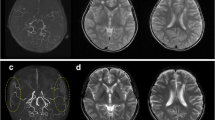Abstract
Purpose
Surgical revascularization for pediatric moyamoya disease improves cerebral blood flow (CBF) and consequently may prevent further ischemic events. However, the timing of the treatment is controversial especially for patients with no ischemic symptom and normal CBF. The purpose of this case report is to inform and infer the surgical treatment timing for pediatric moyamoya disease patients.
Case report
A 10-year-old female patient with unilateral moyamoya disease complaining of only headache as a symptom and whose Suzuki stage was II or in transition to III by angiography and CBF was almost normal was admitted to Tokyo Women’s Medical University Hospital. We performed superficial temporal artery-middle cerebral artery (STA-MCA) double anastomoses for the patient because we estimated her headache was derived from low perfusion in the brain. STA-MCA bypass surgery was not only effective for relief of her severe headache but also valid for her cerebral perfusion. Her angiography showed much supply from external carotid artery to intracranial arteries via bypass grafts in 7 months.
Conclusion
Our case showed early surgical treatment was beneficial for relief of severe headache even for early staged pediatric moyamoya disease patients by improving perfusion pressure and cerebral circulation.



Similar content being viewed by others

References
Choi JU, Kim DS, Kim EY, Lee KC (1997) Natural history of moyamoya disease: comparison of activity of daily living in surgery and non surgery groups. Clin Neurol Neurosurg 99(Suppl 2):S11–18
Hashimoto N, Tominaga T, Miyamoto S, Nagata I, Houkin K, Suzuki N, Koizumi A, Nogawa S, Nakagawara J, Kitagawa K, Kuroda S, Kikuta K, Fujimura M, Takahashi J, Hayashi K, Oki K, Hoshino H, Takagi Y (2012) Guidelines for diagnosis and treatment for moyamoya disease. Neurol Med Chir (Tokyo) 52(5):245–266
Hayashi K, Suyama K, Nagata I (2010) Clinical features of unilateral moyamoya disease. Neurol Med Chir (Tokyo) 50(5):378–85
Houkin K, Nakayama N, Kuroda S, Ishikawa T, Nonaka T (2004) How does angiogenesis develop in pediatric moyamoya disease after surgery? A prospective study with MR angiography. Childs Nerv Syst 20:734–741
Houkin K, Abe H, Yoshimoto T, Takahashi A (1996) Is “unilateral” moyamoya disease different from moyamoya disease? J Neurosurg 85(5):772–6
Imaizumi C, Imaizumi T, Osawa M, Fukuyama Y, Takeshita M (1999) Serial intelligence test scores in pediatric moyamoya disease. Neuropediatrics 30:294–299
Ishii R, Takeuchi S, Ibayashi K, Tanaka R (1984) Intelligence in children with moyamoya disease: evaluation after surgical treatments with special reference to changes in cerebral blood flow. Stroke 15:873–877
Kawabori M, Kuroda S, Nakayama N, Hirata K, Shiga T, Houkin K, Tamaki N (2013) Effective surgical revascularization improves cerebral hemodynamics and resolves headache in pediatric moyamoya disease. World Neurosurg 80(5):612–9. doi:10.1016/j.wneu.2012.08.005, Epub 2012 Sep 25
Kawano T, Fukui M, Hashimoto N, Yonekawa Y (1994) Follow-up study of patients with “unilateral” moyamoya disease. Neurol Med Chir (Tokyo) 34(11):744–7
Kuroda S, Houkin K, Ishikawa T, Nakayama N, Ikeda J, Ishii N, Kamiyama H, Iwasaki Y (2004) Determinants of intellectual outcome after surgical revascularization in pediatric moyamoya disease: a multivariate analysis. Childs Nerv Syst 20:302–308
Okada Y, Kawamata T, Kawashima A, Yamaguchi K, Ono Y, Hori T (2012) The efficacy of superficial temporal artery-middle cerebral artery anastomosis in patients with moyamoya disease complaining of severe headache. J Neurosurg 116:672–679
Okada Y, Shima T, Nishida M, Yamane K, Yamada T, Yamanaka C (1998) Effectiveness of superficial temporal artery-middle cerebral artery anastomosis in adult moyamoya disease: cerebral hemodynamics and clinical course in ischemic and hemorrhagic varieties. Stroke 29:625–630
Olsen J (2004) Headache classification subcommittee of the international headache society. The international classification of headache disorders; 2nd edition. Cephalalgia 24(suppl 1):1–160
Park EK, Lee YH, Shim KW, Choi JU, Kim DS (2011) Natural history and progression factors of unilateral moyamoya disease in pediatric patients. Childs Nerv Syst 27(8):1281–7. doi:10.1007/s00381-011-1469-y, Epub 2011 May 7
Scott RM, Smith JL, Robertson RL, Madsen JR, Soriano SG, Rockoff MA (2004) Long-term outcome in children with moyamoya syndrome after cranial revascularization by pial synangiosis. J Neurosurg 100:142–149
Seol HJ, Wang KC, Kim SK, Hwang YS, Kim KJ, Cho BK (2005) Headache in pediatric moyamoya disease: review of 204 consecutive cases. J Neurosurg 103:439–442
Suzuki J, Kodama N (1983) Moyamoya disease—a review. Stroke 14:104–109
Vuignier S, Akioka N, Hamada H, Kashiwazaki D, Kuroda S (2014) Headache attack followed by rapid disease progression in pediatric moyamoya disease—how should we manage it? Childs Nerv Syst 30(10):1733–6. doi:10.1007/s00381-014-2408-5, Epub 2014 Apr 1
Weinberg DG, Rahme RJ, Aoun SG, Batjer HH, Bendok BR (2011) Moyamoya disease: functional and neurocognitive outcomes in the pediatric and adult populations. Neurosurg Focus 30, E21. doi:10.3171/2011.3.FOCUS1150
Williams TS, Westmacott R, Dlamini N, Granite L, Dirks P, Askalan R, Macgregor D, Moharir M, Deveber G (2012) Intellectual ability and executive function in pediatric moyamoya vasculopathy. Dev Med Child Neurol 54:30–37
Yamada M, Fujii K, Fukui M (2005) Clinical features and outcomes in patients with asymptomatic moyamoya disease—from the results of nation-wide questionnaire survey. No Shinkei Geka 33:337–342
Acknowledgments
We thank David Huang for their guidance and staff of the Department of Neurosurgery, Tokyo Women’s Medical University, in preparing this paper.
Declaration of funding source
This study was supported by research funds of the Department of Neurosurgery, Tokyo Women’s Medical University.
Conflict of interest
The authors have no personal financial or institutional interest in any of the materials or devices described in this article.
Author information
Authors and Affiliations
Corresponding author
Rights and permissions
About this article
Cite this article
Matsuoka, G., Aihara, Y., Yamaguchi, K. et al. Early surgical treatment benefits early staged pediatric moyamoya disease—single case report. Childs Nerv Syst 31, 1195–1199 (2015). https://doi.org/10.1007/s00381-015-2709-3
Received:
Accepted:
Published:
Issue Date:
DOI: https://doi.org/10.1007/s00381-015-2709-3



